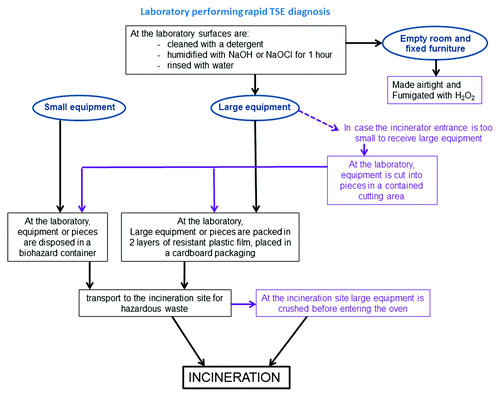Figures & data
Table 1. Human and animal prion diseases, their acronyms and their probable etiology
Table 2. Number of reported cases of bovine spongiform encephalopathy in farmed cattle worldwide
Table 3. Design features, technical characteristics, safety equipment, work practices and waste (disposal) management required in Belgian laboratories that perform rapid BSE detection testing
Table 4. Efficacy of sterilization processes in inactivating prions
Table 5. Efficacy of chemicals in inactivating prions
Figure 1. Procedure for decontamination and dismantlement of laboratories performing rapid detection of Transmissible Spongiform Encephalopathy. Dismantlement starts with equipment and furniture in the room and finishes with decontamination of the emptied room. Small equipment is disposed in a biohazard container without prior decontamination and transported to the incinerator. Large equipment, walls, floor and fixed furniture are cleaned with a detergent and then vaporized (humidified) with NaOH 2N or NaOCl 20 000 ppm for one hour. Surfaces are then rinsed with water. Large equipment is packed in 2 layers of resistant plastic film, placed in cardboard packaging and transported to the incinerator. The room is made airtight and fumigated with hydrogen peroxide. In case of “small” incinerator oven entrance, two solutions are proposed: large equipment is cut in the laboratory into pieces small enough to enter the oven, or large equipment is crushed just before entering the oven at the incineration site. Small and large equipment are incinerated in a specialized incinerator for hazardous waste.
